Nursing Assignment: Learning Outcomes, Prescribing and Patient Care
VerifiedAdded on 2022/10/16
|22
|4795
|19
Homework Assignment
AI Summary
This nursing assignment addresses various learning outcomes related to patient care, prescribing practices, and ethical considerations. It explores scenarios such as accepting referrals, handling patient refusal of treatment, addressing colleague misconduct, and managing conscientious objections. The assignment also delves into the roles and boundaries of a prescribing team, including interprofessional collaboration and support. Furthermore, it examines the specific considerations for prescribing for children, including assessment, communication, diagnosis, and treatment of conditions like eczema, with a focus on evidence-based practice and ethical decision-making. The assignment emphasizes the importance of the NMC code, patient safety, and the nurse's role in advocating for the patient's best interests.
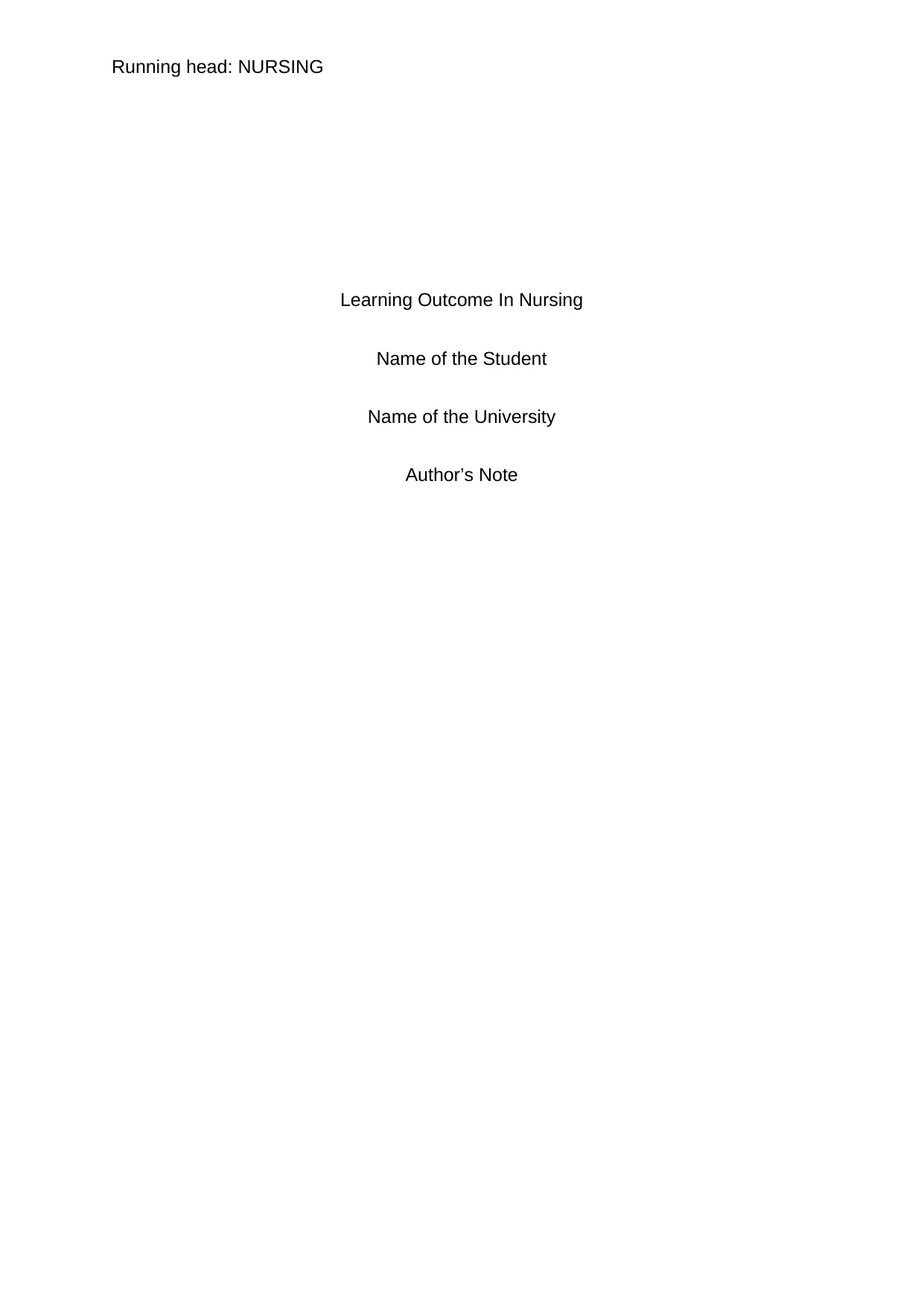
Running head: NURSING
Learning Outcome In Nursing
Name of the Student
Name of the University
Author’s Note
Learning Outcome In Nursing
Name of the Student
Name of the University
Author’s Note
Paraphrase This Document
Need a fresh take? Get an instant paraphrase of this document with our AI Paraphraser
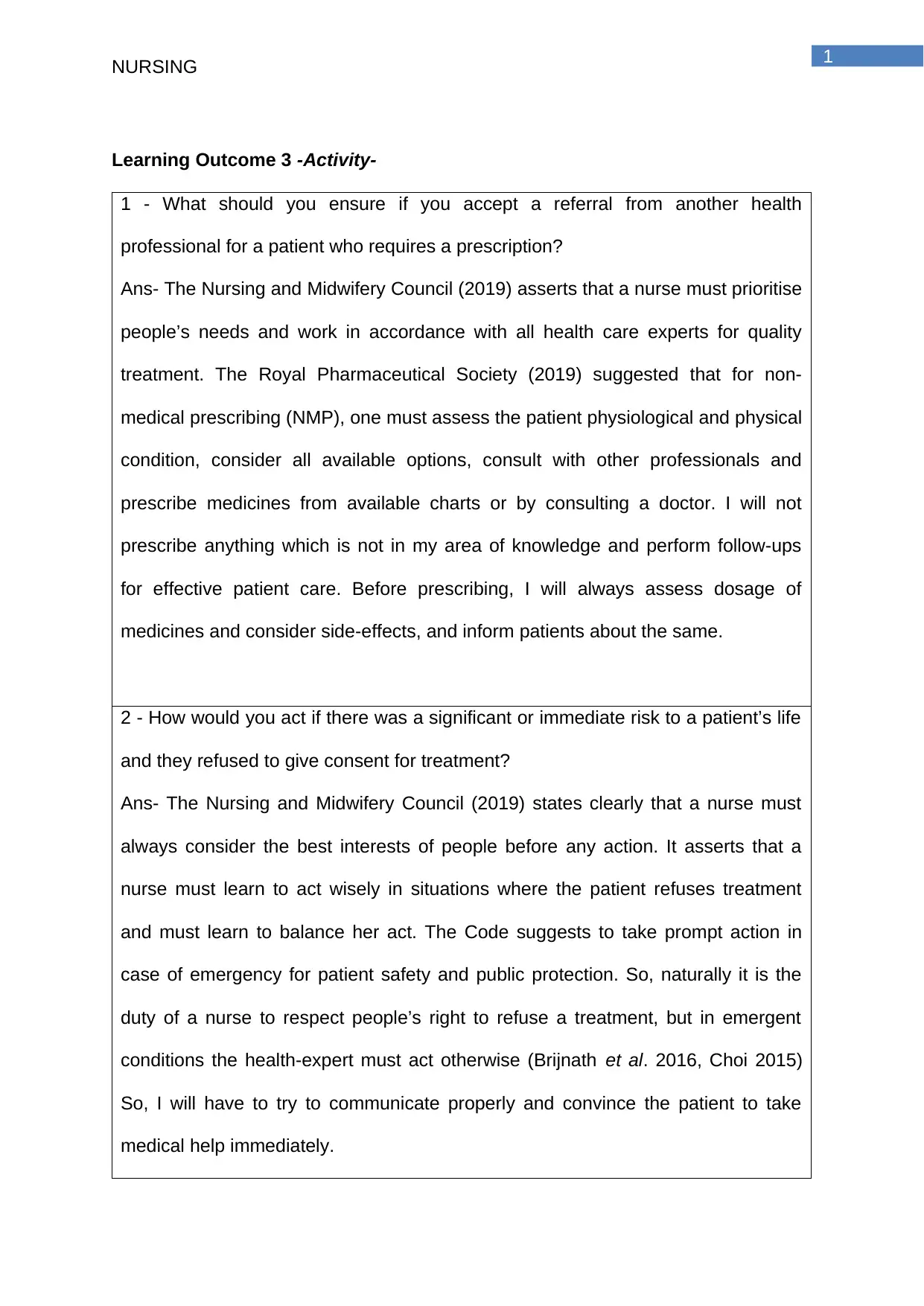
1
NURSING
Learning Outcome 3 -Activity-
1 - What should you ensure if you accept a referral from another health
professional for a patient who requires a prescription?
Ans- The Nursing and Midwifery Council (2019) asserts that a nurse must prioritise
people’s needs and work in accordance with all health care experts for quality
treatment. The Royal Pharmaceutical Society (2019) suggested that for non-
medical prescribing (NMP), one must assess the patient physiological and physical
condition, consider all available options, consult with other professionals and
prescribe medicines from available charts or by consulting a doctor. I will not
prescribe anything which is not in my area of knowledge and perform follow-ups
for effective patient care. Before prescribing, I will always assess dosage of
medicines and consider side-effects, and inform patients about the same.
2 - How would you act if there was a significant or immediate risk to a patient’s life
and they refused to give consent for treatment?
Ans- The Nursing and Midwifery Council (2019) states clearly that a nurse must
always consider the best interests of people before any action. It asserts that a
nurse must learn to act wisely in situations where the patient refuses treatment
and must learn to balance her act. The Code suggests to take prompt action in
case of emergency for patient safety and public protection. So, naturally it is the
duty of a nurse to respect people’s right to refuse a treatment, but in emergent
conditions the health-expert must act otherwise (Brijnath et al. 2016, Choi 2015)
So, I will have to try to communicate properly and convince the patient to take
medical help immediately.
NURSING
Learning Outcome 3 -Activity-
1 - What should you ensure if you accept a referral from another health
professional for a patient who requires a prescription?
Ans- The Nursing and Midwifery Council (2019) asserts that a nurse must prioritise
people’s needs and work in accordance with all health care experts for quality
treatment. The Royal Pharmaceutical Society (2019) suggested that for non-
medical prescribing (NMP), one must assess the patient physiological and physical
condition, consider all available options, consult with other professionals and
prescribe medicines from available charts or by consulting a doctor. I will not
prescribe anything which is not in my area of knowledge and perform follow-ups
for effective patient care. Before prescribing, I will always assess dosage of
medicines and consider side-effects, and inform patients about the same.
2 - How would you act if there was a significant or immediate risk to a patient’s life
and they refused to give consent for treatment?
Ans- The Nursing and Midwifery Council (2019) states clearly that a nurse must
always consider the best interests of people before any action. It asserts that a
nurse must learn to act wisely in situations where the patient refuses treatment
and must learn to balance her act. The Code suggests to take prompt action in
case of emergency for patient safety and public protection. So, naturally it is the
duty of a nurse to respect people’s right to refuse a treatment, but in emergent
conditions the health-expert must act otherwise (Brijnath et al. 2016, Choi 2015)
So, I will have to try to communicate properly and convince the patient to take
medical help immediately.
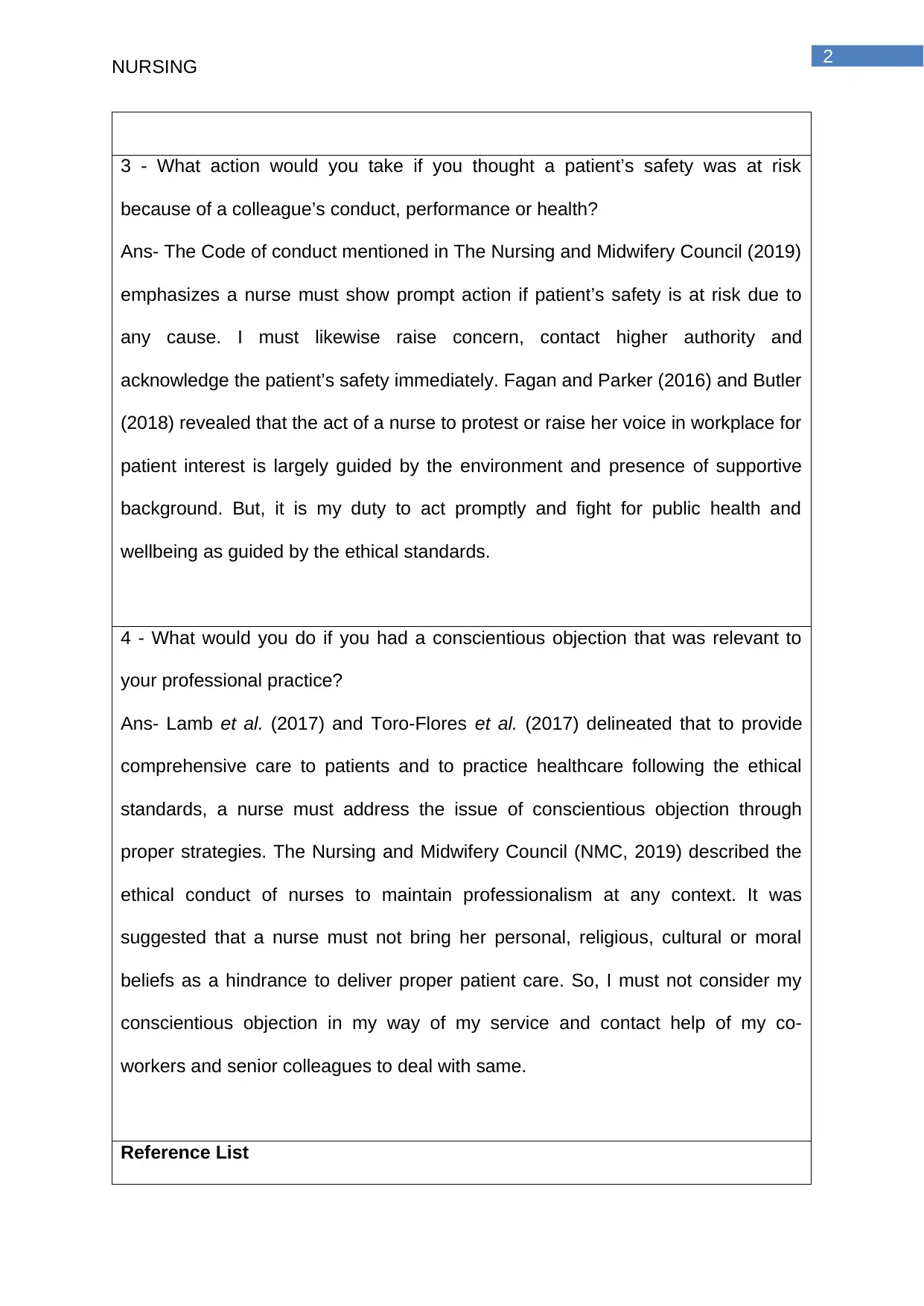
2
NURSING
3 - What action would you take if you thought a patient’s safety was at risk
because of a colleague’s conduct, performance or health?
Ans- The Code of conduct mentioned in The Nursing and Midwifery Council (2019)
emphasizes a nurse must show prompt action if patient’s safety is at risk due to
any cause. I must likewise raise concern, contact higher authority and
acknowledge the patient’s safety immediately. Fagan and Parker (2016) and Butler
(2018) revealed that the act of a nurse to protest or raise her voice in workplace for
patient interest is largely guided by the environment and presence of supportive
background. But, it is my duty to act promptly and fight for public health and
wellbeing as guided by the ethical standards.
4 - What would you do if you had a conscientious objection that was relevant to
your professional practice?
Ans- Lamb et al. (2017) and Toro-Flores et al. (2017) delineated that to provide
comprehensive care to patients and to practice healthcare following the ethical
standards, a nurse must address the issue of conscientious objection through
proper strategies. The Nursing and Midwifery Council (NMC, 2019) described the
ethical conduct of nurses to maintain professionalism at any context. It was
suggested that a nurse must not bring her personal, religious, cultural or moral
beliefs as a hindrance to deliver proper patient care. So, I must not consider my
conscientious objection in my way of my service and contact help of my co-
workers and senior colleagues to deal with same.
Reference List
NURSING
3 - What action would you take if you thought a patient’s safety was at risk
because of a colleague’s conduct, performance or health?
Ans- The Code of conduct mentioned in The Nursing and Midwifery Council (2019)
emphasizes a nurse must show prompt action if patient’s safety is at risk due to
any cause. I must likewise raise concern, contact higher authority and
acknowledge the patient’s safety immediately. Fagan and Parker (2016) and Butler
(2018) revealed that the act of a nurse to protest or raise her voice in workplace for
patient interest is largely guided by the environment and presence of supportive
background. But, it is my duty to act promptly and fight for public health and
wellbeing as guided by the ethical standards.
4 - What would you do if you had a conscientious objection that was relevant to
your professional practice?
Ans- Lamb et al. (2017) and Toro-Flores et al. (2017) delineated that to provide
comprehensive care to patients and to practice healthcare following the ethical
standards, a nurse must address the issue of conscientious objection through
proper strategies. The Nursing and Midwifery Council (NMC, 2019) described the
ethical conduct of nurses to maintain professionalism at any context. It was
suggested that a nurse must not bring her personal, religious, cultural or moral
beliefs as a hindrance to deliver proper patient care. So, I must not consider my
conscientious objection in my way of my service and contact help of my co-
workers and senior colleagues to deal with same.
Reference List
⊘ This is a preview!⊘
Do you want full access?
Subscribe today to unlock all pages.

Trusted by 1+ million students worldwide
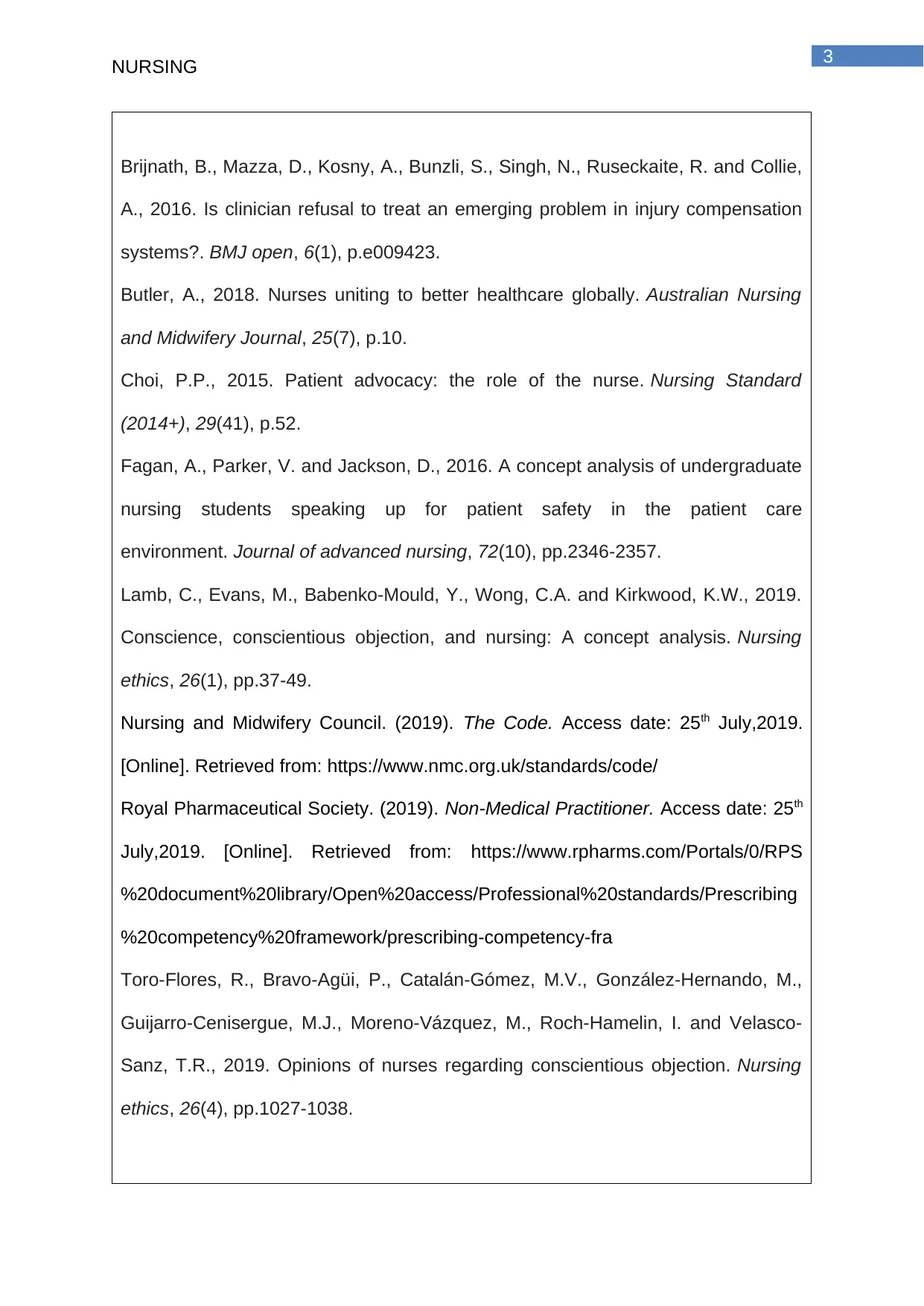
3
NURSING
Brijnath, B., Mazza, D., Kosny, A., Bunzli, S., Singh, N., Ruseckaite, R. and Collie,
A., 2016. Is clinician refusal to treat an emerging problem in injury compensation
systems?. BMJ open, 6(1), p.e009423.
Butler, A., 2018. Nurses uniting to better healthcare globally. Australian Nursing
and Midwifery Journal, 25(7), p.10.
Choi, P.P., 2015. Patient advocacy: the role of the nurse. Nursing Standard
(2014+), 29(41), p.52.
Fagan, A., Parker, V. and Jackson, D., 2016. A concept analysis of undergraduate
nursing students speaking up for patient safety in the patient care
environment. Journal of advanced nursing, 72(10), pp.2346-2357.
Lamb, C., Evans, M., Babenko-Mould, Y., Wong, C.A. and Kirkwood, K.W., 2019.
Conscience, conscientious objection, and nursing: A concept analysis. Nursing
ethics, 26(1), pp.37-49.
Nursing and Midwifery Council. (2019). The Code. Access date: 25th July,2019.
[Online]. Retrieved from: https://www.nmc.org.uk/standards/code/
Royal Pharmaceutical Society. (2019). Non-Medical Practitioner. Access date: 25th
July,2019. [Online]. Retrieved from: https://www.rpharms.com/Portals/0/RPS
%20document%20library/Open%20access/Professional%20standards/Prescribing
%20competency%20framework/prescribing-competency-fra
Toro-Flores, R., Bravo-Agüi, P., Catalán-Gómez, M.V., González-Hernando, M.,
Guijarro-Cenisergue, M.J., Moreno-Vázquez, M., Roch-Hamelin, I. and Velasco-
Sanz, T.R., 2019. Opinions of nurses regarding conscientious objection. Nursing
ethics, 26(4), pp.1027-1038.
NURSING
Brijnath, B., Mazza, D., Kosny, A., Bunzli, S., Singh, N., Ruseckaite, R. and Collie,
A., 2016. Is clinician refusal to treat an emerging problem in injury compensation
systems?. BMJ open, 6(1), p.e009423.
Butler, A., 2018. Nurses uniting to better healthcare globally. Australian Nursing
and Midwifery Journal, 25(7), p.10.
Choi, P.P., 2015. Patient advocacy: the role of the nurse. Nursing Standard
(2014+), 29(41), p.52.
Fagan, A., Parker, V. and Jackson, D., 2016. A concept analysis of undergraduate
nursing students speaking up for patient safety in the patient care
environment. Journal of advanced nursing, 72(10), pp.2346-2357.
Lamb, C., Evans, M., Babenko-Mould, Y., Wong, C.A. and Kirkwood, K.W., 2019.
Conscience, conscientious objection, and nursing: A concept analysis. Nursing
ethics, 26(1), pp.37-49.
Nursing and Midwifery Council. (2019). The Code. Access date: 25th July,2019.
[Online]. Retrieved from: https://www.nmc.org.uk/standards/code/
Royal Pharmaceutical Society. (2019). Non-Medical Practitioner. Access date: 25th
July,2019. [Online]. Retrieved from: https://www.rpharms.com/Portals/0/RPS
%20document%20library/Open%20access/Professional%20standards/Prescribing
%20competency%20framework/prescribing-competency-fra
Toro-Flores, R., Bravo-Agüi, P., Catalán-Gómez, M.V., González-Hernando, M.,
Guijarro-Cenisergue, M.J., Moreno-Vázquez, M., Roch-Hamelin, I. and Velasco-
Sanz, T.R., 2019. Opinions of nurses regarding conscientious objection. Nursing
ethics, 26(4), pp.1027-1038.
Paraphrase This Document
Need a fresh take? Get an instant paraphrase of this document with our AI Paraphraser
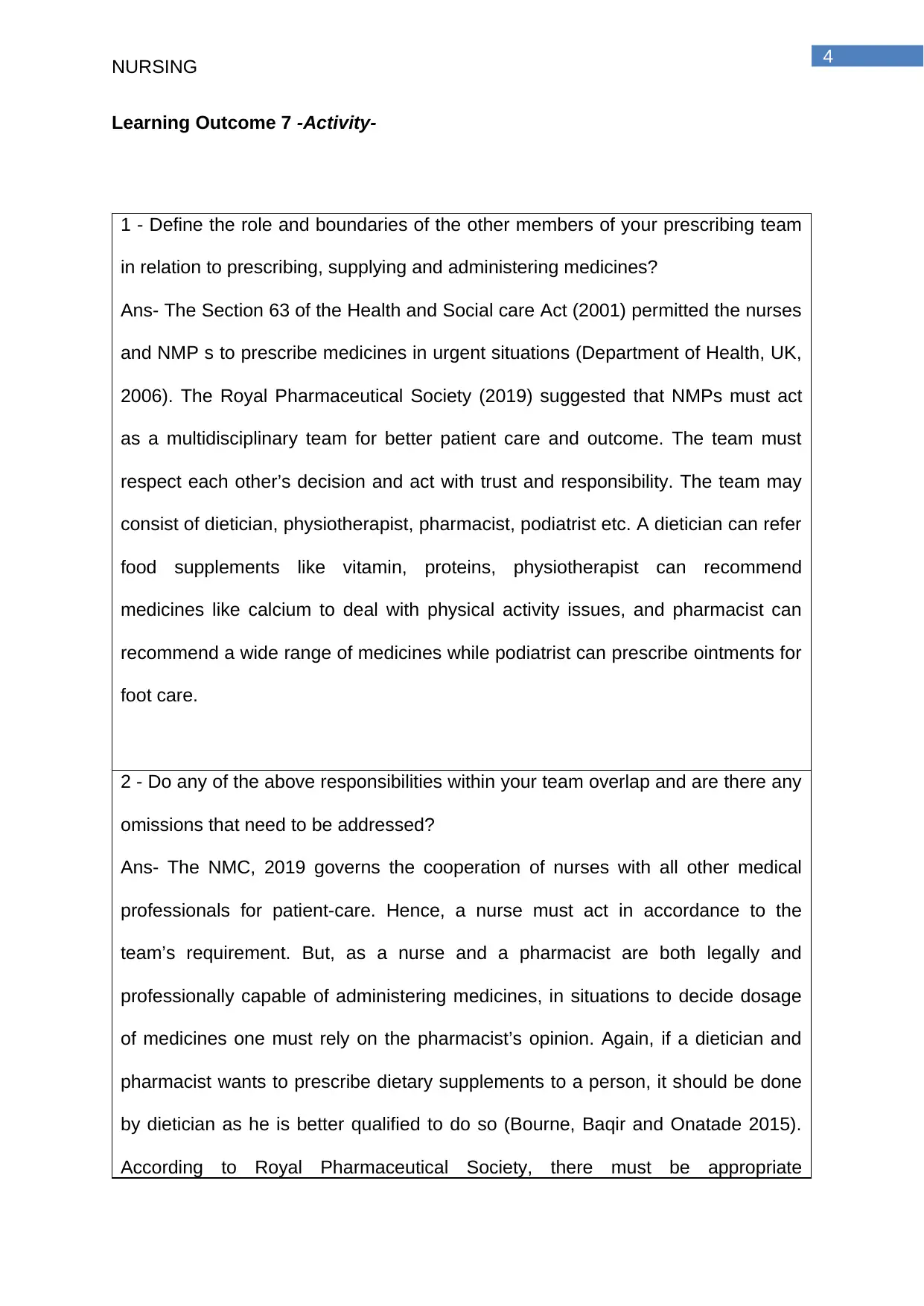
4
NURSING
Learning Outcome 7 -Activity-
1 - Define the role and boundaries of the other members of your prescribing team
in relation to prescribing, supplying and administering medicines?
Ans- The Section 63 of the Health and Social care Act (2001) permitted the nurses
and NMP s to prescribe medicines in urgent situations (Department of Health, UK,
2006). The Royal Pharmaceutical Society (2019) suggested that NMPs must act
as a multidisciplinary team for better patient care and outcome. The team must
respect each other’s decision and act with trust and responsibility. The team may
consist of dietician, physiotherapist, pharmacist, podiatrist etc. A dietician can refer
food supplements like vitamin, proteins, physiotherapist can recommend
medicines like calcium to deal with physical activity issues, and pharmacist can
recommend a wide range of medicines while podiatrist can prescribe ointments for
foot care.
2 - Do any of the above responsibilities within your team overlap and are there any
omissions that need to be addressed?
Ans- The NMC, 2019 governs the cooperation of nurses with all other medical
professionals for patient-care. Hence, a nurse must act in accordance to the
team’s requirement. But, as a nurse and a pharmacist are both legally and
professionally capable of administering medicines, in situations to decide dosage
of medicines one must rely on the pharmacist’s opinion. Again, if a dietician and
pharmacist wants to prescribe dietary supplements to a person, it should be done
by dietician as he is better qualified to do so (Bourne, Baqir and Onatade 2015).
According to Royal Pharmaceutical Society, there must be appropriate
NURSING
Learning Outcome 7 -Activity-
1 - Define the role and boundaries of the other members of your prescribing team
in relation to prescribing, supplying and administering medicines?
Ans- The Section 63 of the Health and Social care Act (2001) permitted the nurses
and NMP s to prescribe medicines in urgent situations (Department of Health, UK,
2006). The Royal Pharmaceutical Society (2019) suggested that NMPs must act
as a multidisciplinary team for better patient care and outcome. The team must
respect each other’s decision and act with trust and responsibility. The team may
consist of dietician, physiotherapist, pharmacist, podiatrist etc. A dietician can refer
food supplements like vitamin, proteins, physiotherapist can recommend
medicines like calcium to deal with physical activity issues, and pharmacist can
recommend a wide range of medicines while podiatrist can prescribe ointments for
foot care.
2 - Do any of the above responsibilities within your team overlap and are there any
omissions that need to be addressed?
Ans- The NMC, 2019 governs the cooperation of nurses with all other medical
professionals for patient-care. Hence, a nurse must act in accordance to the
team’s requirement. But, as a nurse and a pharmacist are both legally and
professionally capable of administering medicines, in situations to decide dosage
of medicines one must rely on the pharmacist’s opinion. Again, if a dietician and
pharmacist wants to prescribe dietary supplements to a person, it should be done
by dietician as he is better qualified to do so (Bourne, Baqir and Onatade 2015).
According to Royal Pharmaceutical Society, there must be appropriate
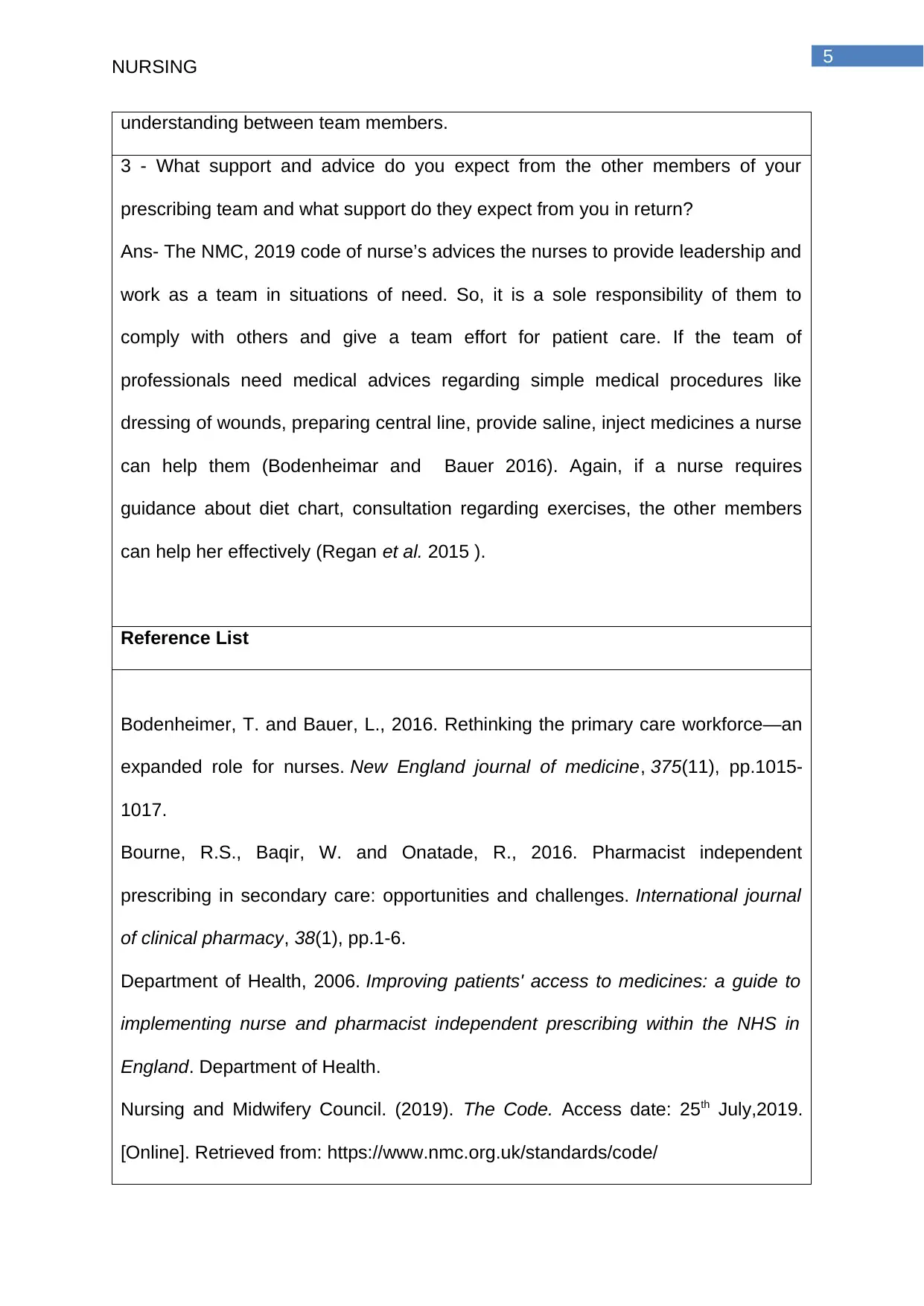
5
NURSING
understanding between team members.
3 - What support and advice do you expect from the other members of your
prescribing team and what support do they expect from you in return?
Ans- The NMC, 2019 code of nurse’s advices the nurses to provide leadership and
work as a team in situations of need. So, it is a sole responsibility of them to
comply with others and give a team effort for patient care. If the team of
professionals need medical advices regarding simple medical procedures like
dressing of wounds, preparing central line, provide saline, inject medicines a nurse
can help them (Bodenheimar and Bauer 2016). Again, if a nurse requires
guidance about diet chart, consultation regarding exercises, the other members
can help her effectively (Regan et al. 2015 ).
Reference List
Bodenheimer, T. and Bauer, L., 2016. Rethinking the primary care workforce—an
expanded role for nurses. New England journal of medicine, 375(11), pp.1015-
1017.
Bourne, R.S., Baqir, W. and Onatade, R., 2016. Pharmacist independent
prescribing in secondary care: opportunities and challenges. International journal
of clinical pharmacy, 38(1), pp.1-6.
Department of Health, 2006. Improving patients' access to medicines: a guide to
implementing nurse and pharmacist independent prescribing within the NHS in
England. Department of Health.
Nursing and Midwifery Council. (2019). The Code. Access date: 25th July,2019.
[Online]. Retrieved from: https://www.nmc.org.uk/standards/code/
NURSING
understanding between team members.
3 - What support and advice do you expect from the other members of your
prescribing team and what support do they expect from you in return?
Ans- The NMC, 2019 code of nurse’s advices the nurses to provide leadership and
work as a team in situations of need. So, it is a sole responsibility of them to
comply with others and give a team effort for patient care. If the team of
professionals need medical advices regarding simple medical procedures like
dressing of wounds, preparing central line, provide saline, inject medicines a nurse
can help them (Bodenheimar and Bauer 2016). Again, if a nurse requires
guidance about diet chart, consultation regarding exercises, the other members
can help her effectively (Regan et al. 2015 ).
Reference List
Bodenheimer, T. and Bauer, L., 2016. Rethinking the primary care workforce—an
expanded role for nurses. New England journal of medicine, 375(11), pp.1015-
1017.
Bourne, R.S., Baqir, W. and Onatade, R., 2016. Pharmacist independent
prescribing in secondary care: opportunities and challenges. International journal
of clinical pharmacy, 38(1), pp.1-6.
Department of Health, 2006. Improving patients' access to medicines: a guide to
implementing nurse and pharmacist independent prescribing within the NHS in
England. Department of Health.
Nursing and Midwifery Council. (2019). The Code. Access date: 25th July,2019.
[Online]. Retrieved from: https://www.nmc.org.uk/standards/code/
⊘ This is a preview!⊘
Do you want full access?
Subscribe today to unlock all pages.

Trusted by 1+ million students worldwide
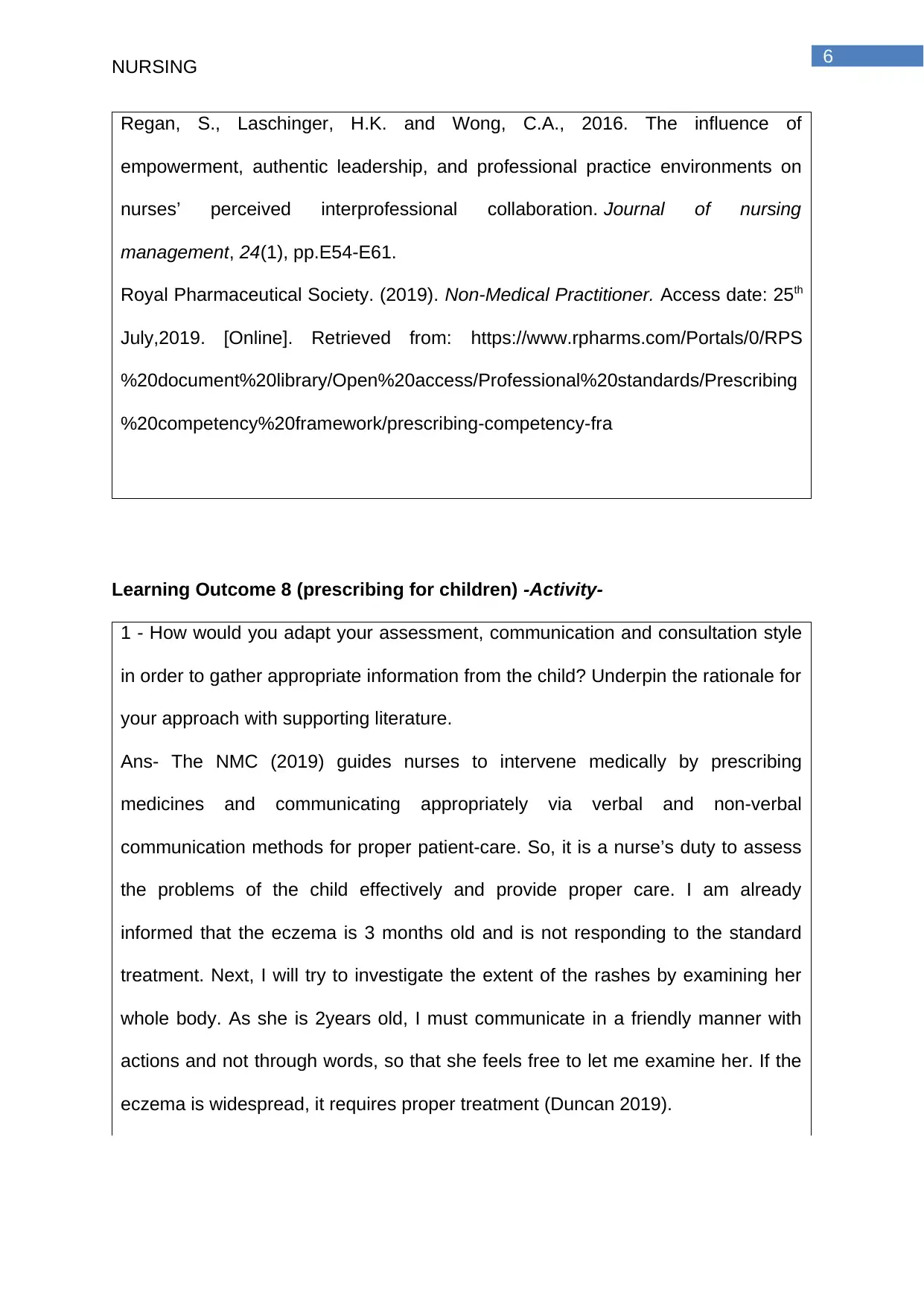
6
NURSING
Regan, S., Laschinger, H.K. and Wong, C.A., 2016. The influence of
empowerment, authentic leadership, and professional practice environments on
nurses’ perceived interprofessional collaboration. Journal of nursing
management, 24(1), pp.E54-E61.
Royal Pharmaceutical Society. (2019). Non-Medical Practitioner. Access date: 25th
July,2019. [Online]. Retrieved from: https://www.rpharms.com/Portals/0/RPS
%20document%20library/Open%20access/Professional%20standards/Prescribing
%20competency%20framework/prescribing-competency-fra
Learning Outcome 8 (prescribing for children) -Activity-
1 - How would you adapt your assessment, communication and consultation style
in order to gather appropriate information from the child? Underpin the rationale for
your approach with supporting literature.
Ans- The NMC (2019) guides nurses to intervene medically by prescribing
medicines and communicating appropriately via verbal and non-verbal
communication methods for proper patient-care. So, it is a nurse’s duty to assess
the problems of the child effectively and provide proper care. I am already
informed that the eczema is 3 months old and is not responding to the standard
treatment. Next, I will try to investigate the extent of the rashes by examining her
whole body. As she is 2years old, I must communicate in a friendly manner with
actions and not through words, so that she feels free to let me examine her. If the
eczema is widespread, it requires proper treatment (Duncan 2019).
NURSING
Regan, S., Laschinger, H.K. and Wong, C.A., 2016. The influence of
empowerment, authentic leadership, and professional practice environments on
nurses’ perceived interprofessional collaboration. Journal of nursing
management, 24(1), pp.E54-E61.
Royal Pharmaceutical Society. (2019). Non-Medical Practitioner. Access date: 25th
July,2019. [Online]. Retrieved from: https://www.rpharms.com/Portals/0/RPS
%20document%20library/Open%20access/Professional%20standards/Prescribing
%20competency%20framework/prescribing-competency-fra
Learning Outcome 8 (prescribing for children) -Activity-
1 - How would you adapt your assessment, communication and consultation style
in order to gather appropriate information from the child? Underpin the rationale for
your approach with supporting literature.
Ans- The NMC (2019) guides nurses to intervene medically by prescribing
medicines and communicating appropriately via verbal and non-verbal
communication methods for proper patient-care. So, it is a nurse’s duty to assess
the problems of the child effectively and provide proper care. I am already
informed that the eczema is 3 months old and is not responding to the standard
treatment. Next, I will try to investigate the extent of the rashes by examining her
whole body. As she is 2years old, I must communicate in a friendly manner with
actions and not through words, so that she feels free to let me examine her. If the
eczema is widespread, it requires proper treatment (Duncan 2019).
Paraphrase This Document
Need a fresh take? Get an instant paraphrase of this document with our AI Paraphraser
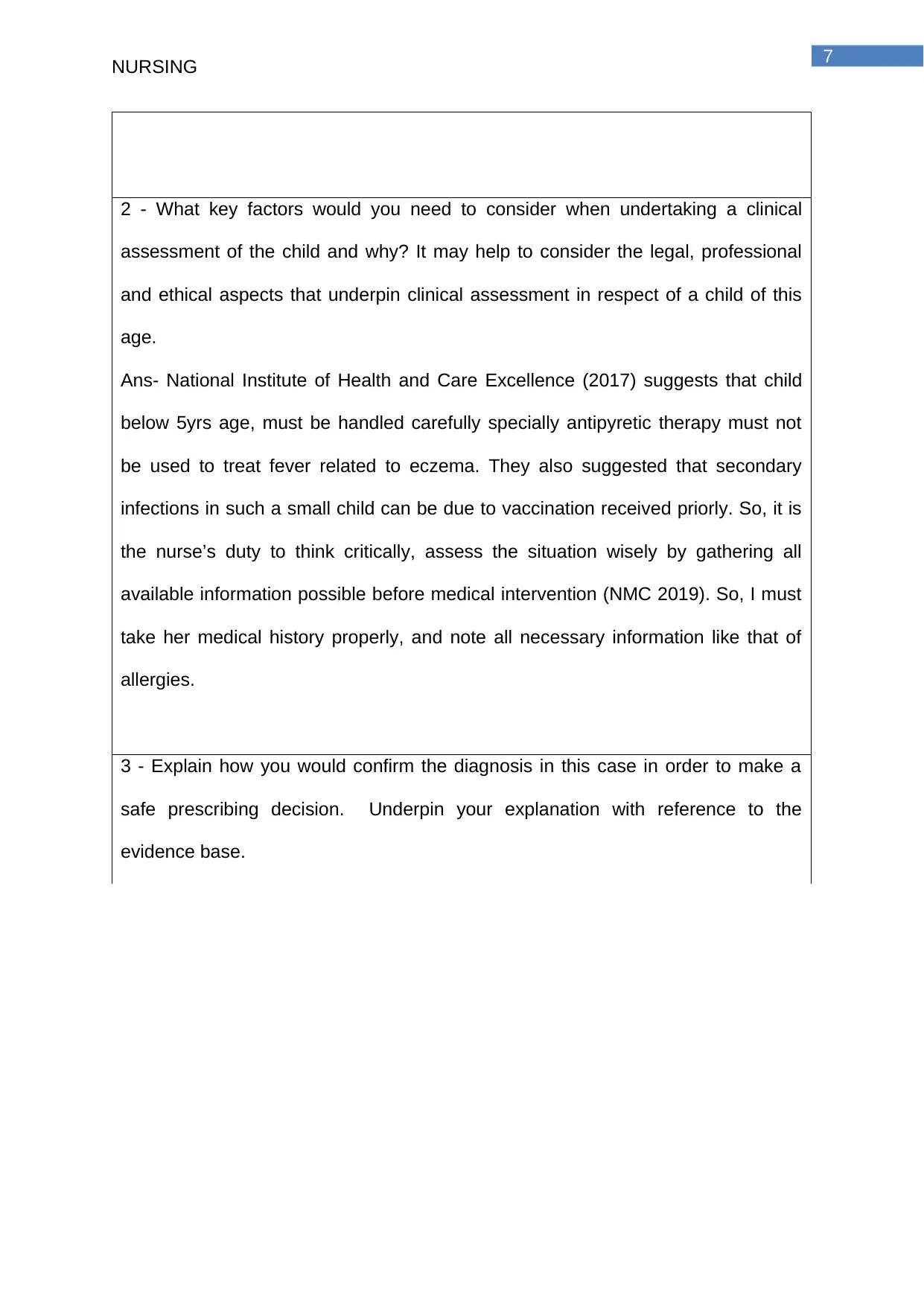
7
NURSING
2 - What key factors would you need to consider when undertaking a clinical
assessment of the child and why? It may help to consider the legal, professional
and ethical aspects that underpin clinical assessment in respect of a child of this
age.
Ans- National Institute of Health and Care Excellence (2017) suggests that child
below 5yrs age, must be handled carefully specially antipyretic therapy must not
be used to treat fever related to eczema. They also suggested that secondary
infections in such a small child can be due to vaccination received priorly. So, it is
the nurse’s duty to think critically, assess the situation wisely by gathering all
available information possible before medical intervention (NMC 2019). So, I must
take her medical history properly, and note all necessary information like that of
allergies.
3 - Explain how you would confirm the diagnosis in this case in order to make a
safe prescribing decision. Underpin your explanation with reference to the
evidence base.
NURSING
2 - What key factors would you need to consider when undertaking a clinical
assessment of the child and why? It may help to consider the legal, professional
and ethical aspects that underpin clinical assessment in respect of a child of this
age.
Ans- National Institute of Health and Care Excellence (2017) suggests that child
below 5yrs age, must be handled carefully specially antipyretic therapy must not
be used to treat fever related to eczema. They also suggested that secondary
infections in such a small child can be due to vaccination received priorly. So, it is
the nurse’s duty to think critically, assess the situation wisely by gathering all
available information possible before medical intervention (NMC 2019). So, I must
take her medical history properly, and note all necessary information like that of
allergies.
3 - Explain how you would confirm the diagnosis in this case in order to make a
safe prescribing decision. Underpin your explanation with reference to the
evidence base.
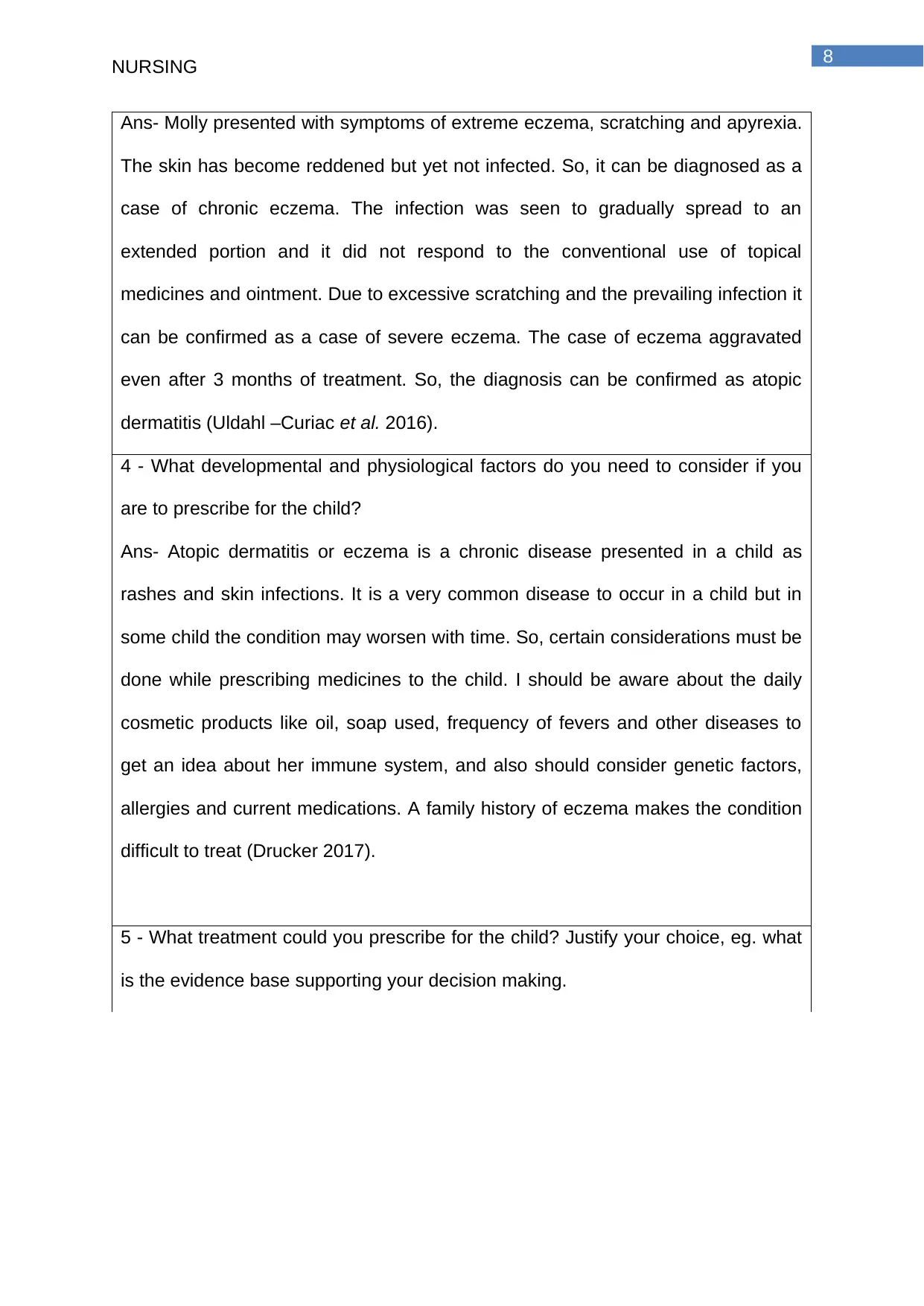
8
NURSING
Ans- Molly presented with symptoms of extreme eczema, scratching and apyrexia.
The skin has become reddened but yet not infected. So, it can be diagnosed as a
case of chronic eczema. The infection was seen to gradually spread to an
extended portion and it did not respond to the conventional use of topical
medicines and ointment. Due to excessive scratching and the prevailing infection it
can be confirmed as a case of severe eczema. The case of eczema aggravated
even after 3 months of treatment. So, the diagnosis can be confirmed as atopic
dermatitis (Uldahl –Curiac et al. 2016).
4 - What developmental and physiological factors do you need to consider if you
are to prescribe for the child?
Ans- Atopic dermatitis or eczema is a chronic disease presented in a child as
rashes and skin infections. It is a very common disease to occur in a child but in
some child the condition may worsen with time. So, certain considerations must be
done while prescribing medicines to the child. I should be aware about the daily
cosmetic products like oil, soap used, frequency of fevers and other diseases to
get an idea about her immune system, and also should consider genetic factors,
allergies and current medications. A family history of eczema makes the condition
difficult to treat (Drucker 2017).
5 - What treatment could you prescribe for the child? Justify your choice, eg. what
is the evidence base supporting your decision making.
NURSING
Ans- Molly presented with symptoms of extreme eczema, scratching and apyrexia.
The skin has become reddened but yet not infected. So, it can be diagnosed as a
case of chronic eczema. The infection was seen to gradually spread to an
extended portion and it did not respond to the conventional use of topical
medicines and ointment. Due to excessive scratching and the prevailing infection it
can be confirmed as a case of severe eczema. The case of eczema aggravated
even after 3 months of treatment. So, the diagnosis can be confirmed as atopic
dermatitis (Uldahl –Curiac et al. 2016).
4 - What developmental and physiological factors do you need to consider if you
are to prescribe for the child?
Ans- Atopic dermatitis or eczema is a chronic disease presented in a child as
rashes and skin infections. It is a very common disease to occur in a child but in
some child the condition may worsen with time. So, certain considerations must be
done while prescribing medicines to the child. I should be aware about the daily
cosmetic products like oil, soap used, frequency of fevers and other diseases to
get an idea about her immune system, and also should consider genetic factors,
allergies and current medications. A family history of eczema makes the condition
difficult to treat (Drucker 2017).
5 - What treatment could you prescribe for the child? Justify your choice, eg. what
is the evidence base supporting your decision making.
⊘ This is a preview!⊘
Do you want full access?
Subscribe today to unlock all pages.

Trusted by 1+ million students worldwide
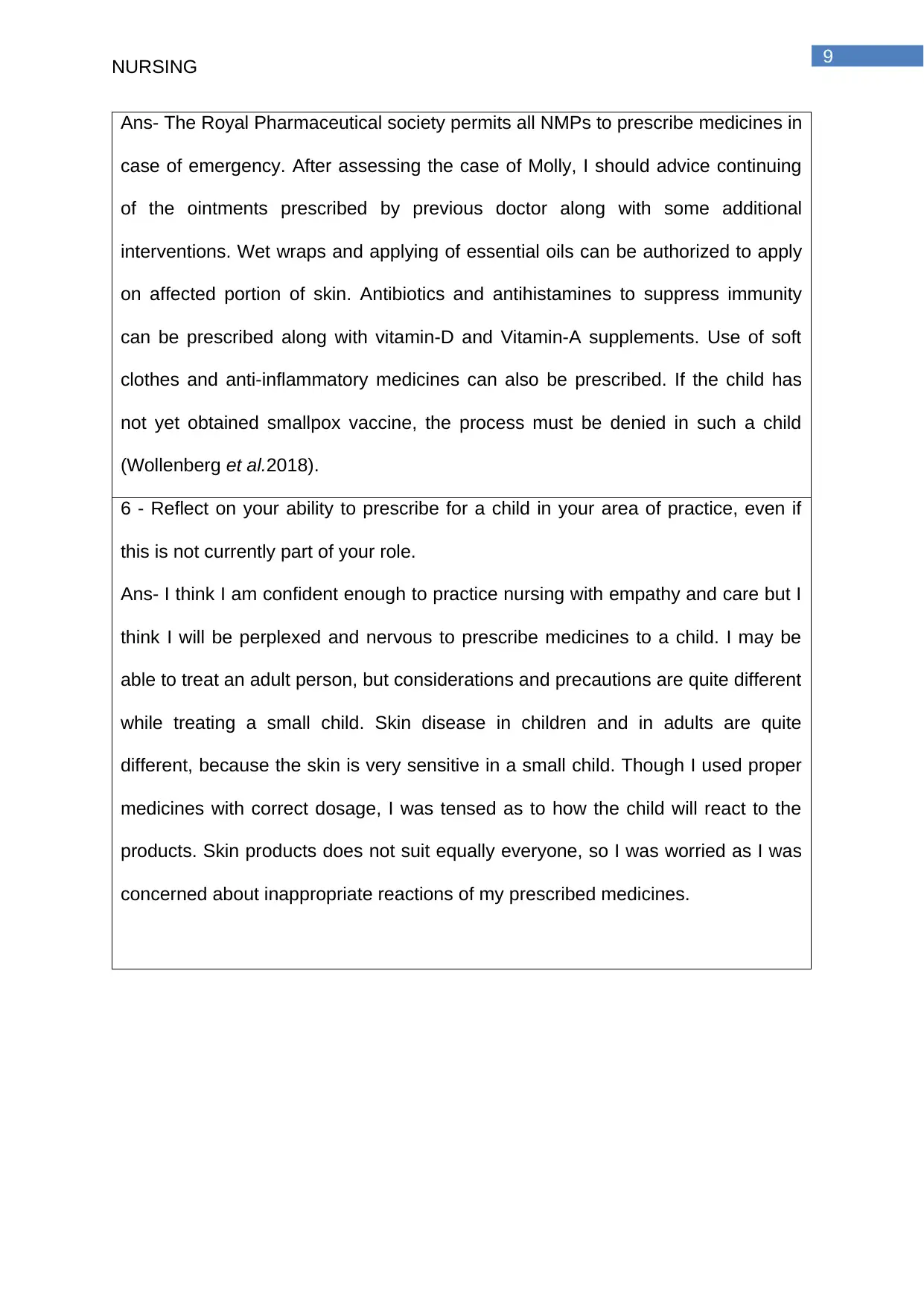
9
NURSING
Ans- The Royal Pharmaceutical society permits all NMPs to prescribe medicines in
case of emergency. After assessing the case of Molly, I should advice continuing
of the ointments prescribed by previous doctor along with some additional
interventions. Wet wraps and applying of essential oils can be authorized to apply
on affected portion of skin. Antibiotics and antihistamines to suppress immunity
can be prescribed along with vitamin-D and Vitamin-A supplements. Use of soft
clothes and anti-inflammatory medicines can also be prescribed. If the child has
not yet obtained smallpox vaccine, the process must be denied in such a child
(Wollenberg et al.2018).
6 - Reflect on your ability to prescribe for a child in your area of practice, even if
this is not currently part of your role.
Ans- I think I am confident enough to practice nursing with empathy and care but I
think I will be perplexed and nervous to prescribe medicines to a child. I may be
able to treat an adult person, but considerations and precautions are quite different
while treating a small child. Skin disease in children and in adults are quite
different, because the skin is very sensitive in a small child. Though I used proper
medicines with correct dosage, I was tensed as to how the child will react to the
products. Skin products does not suit equally everyone, so I was worried as I was
concerned about inappropriate reactions of my prescribed medicines.
NURSING
Ans- The Royal Pharmaceutical society permits all NMPs to prescribe medicines in
case of emergency. After assessing the case of Molly, I should advice continuing
of the ointments prescribed by previous doctor along with some additional
interventions. Wet wraps and applying of essential oils can be authorized to apply
on affected portion of skin. Antibiotics and antihistamines to suppress immunity
can be prescribed along with vitamin-D and Vitamin-A supplements. Use of soft
clothes and anti-inflammatory medicines can also be prescribed. If the child has
not yet obtained smallpox vaccine, the process must be denied in such a child
(Wollenberg et al.2018).
6 - Reflect on your ability to prescribe for a child in your area of practice, even if
this is not currently part of your role.
Ans- I think I am confident enough to practice nursing with empathy and care but I
think I will be perplexed and nervous to prescribe medicines to a child. I may be
able to treat an adult person, but considerations and precautions are quite different
while treating a small child. Skin disease in children and in adults are quite
different, because the skin is very sensitive in a small child. Though I used proper
medicines with correct dosage, I was tensed as to how the child will react to the
products. Skin products does not suit equally everyone, so I was worried as I was
concerned about inappropriate reactions of my prescribed medicines.
Paraphrase This Document
Need a fresh take? Get an instant paraphrase of this document with our AI Paraphraser
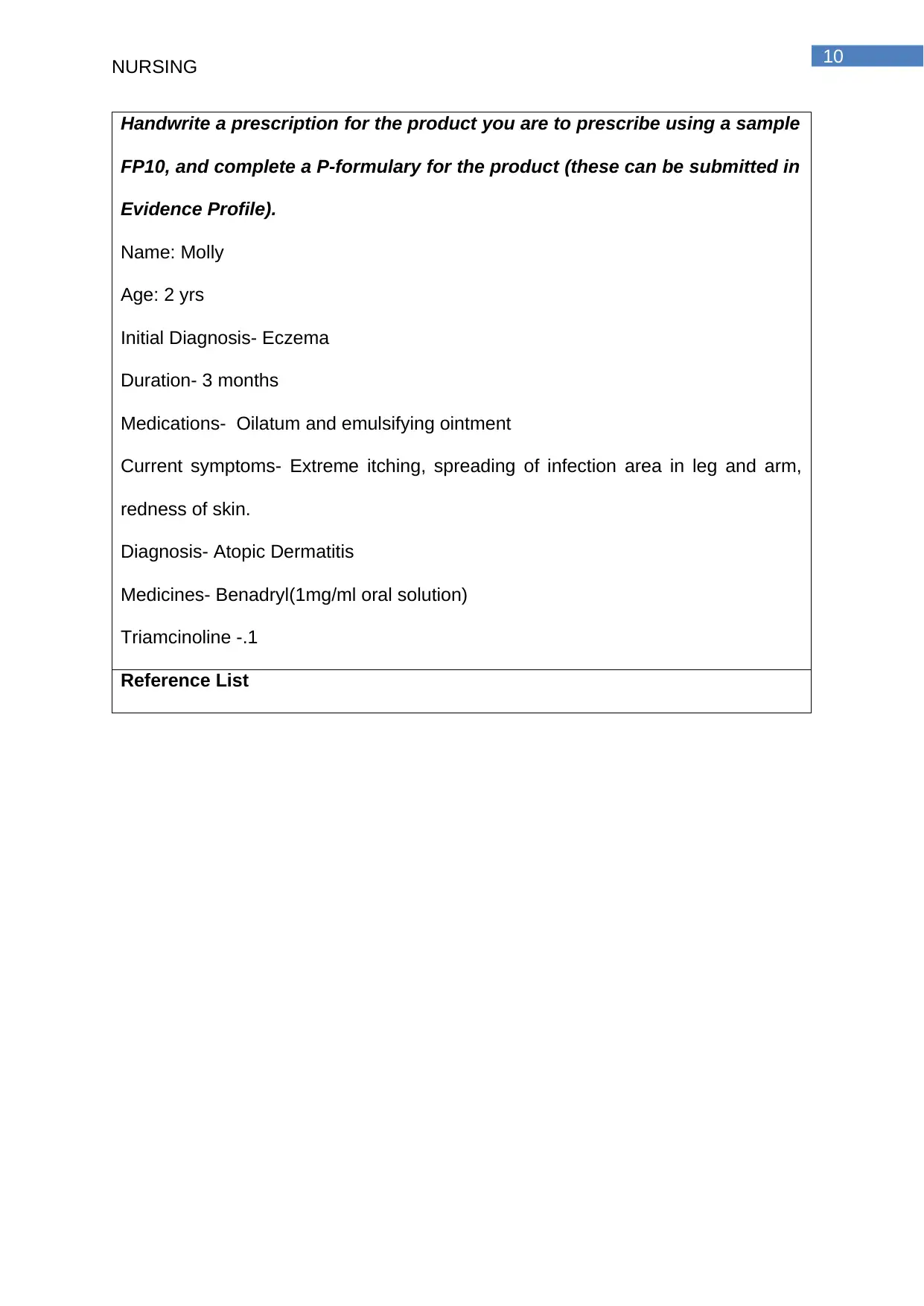
10
NURSING
Handwrite a prescription for the product you are to prescribe using a sample
FP10, and complete a P-formulary for the product (these can be submitted in
Evidence Profile).
Name: Molly
Age: 2 yrs
Initial Diagnosis- Eczema
Duration- 3 months
Medications- Oilatum and emulsifying ointment
Current symptoms- Extreme itching, spreading of infection area in leg and arm,
redness of skin.
Diagnosis- Atopic Dermatitis
Medicines- Benadryl(1mg/ml oral solution)
Triamcinoline -.1
Reference List
NURSING
Handwrite a prescription for the product you are to prescribe using a sample
FP10, and complete a P-formulary for the product (these can be submitted in
Evidence Profile).
Name: Molly
Age: 2 yrs
Initial Diagnosis- Eczema
Duration- 3 months
Medications- Oilatum and emulsifying ointment
Current symptoms- Extreme itching, spreading of infection area in leg and arm,
redness of skin.
Diagnosis- Atopic Dermatitis
Medicines- Benadryl(1mg/ml oral solution)
Triamcinoline -.1
Reference List
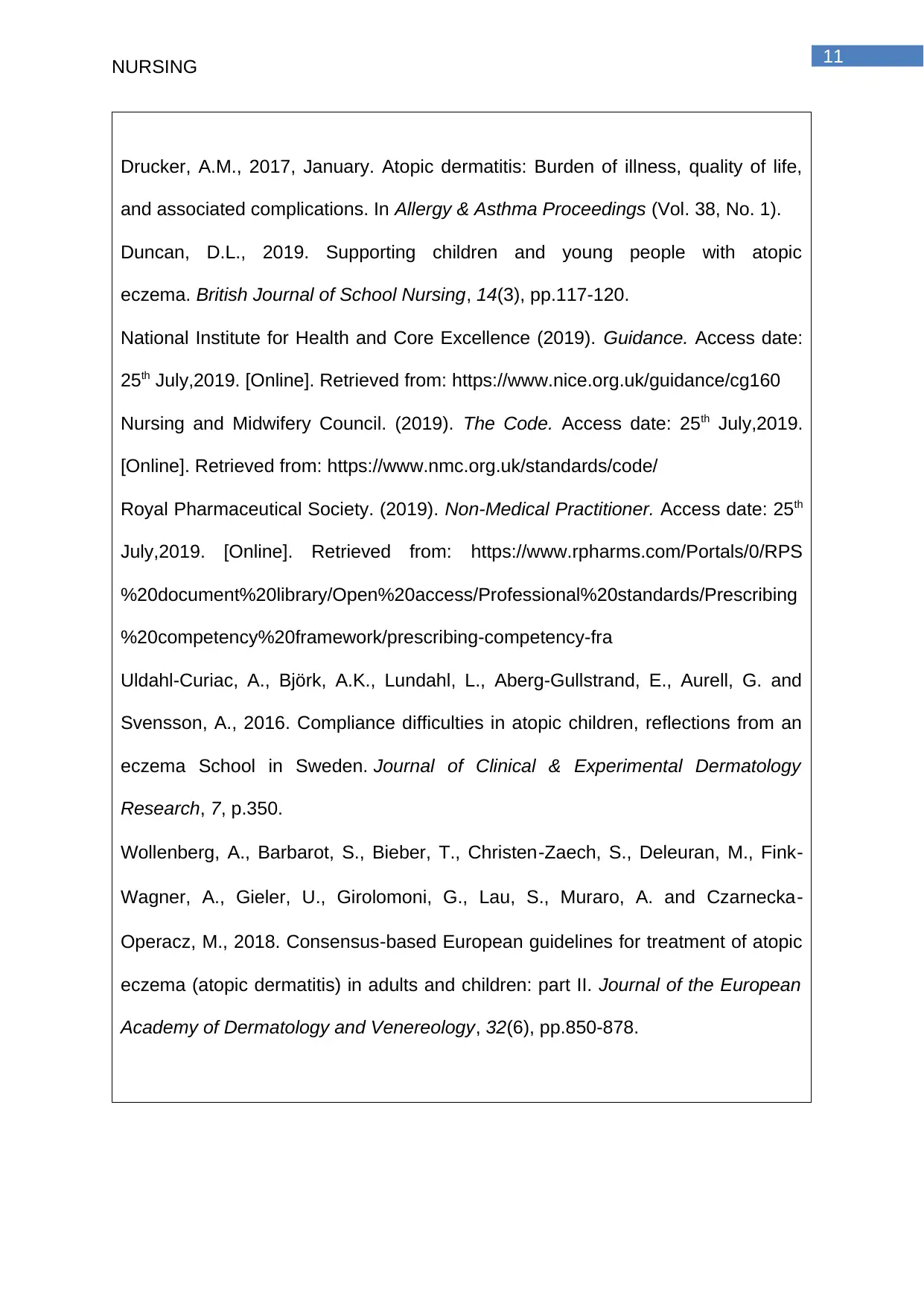
11
NURSING
Drucker, A.M., 2017, January. Atopic dermatitis: Burden of illness, quality of life,
and associated complications. In Allergy & Asthma Proceedings (Vol. 38, No. 1).
Duncan, D.L., 2019. Supporting children and young people with atopic
eczema. British Journal of School Nursing, 14(3), pp.117-120.
National Institute for Health and Core Excellence (2019). Guidance. Access date:
25th July,2019. [Online]. Retrieved from: https://www.nice.org.uk/guidance/cg160
Nursing and Midwifery Council. (2019). The Code. Access date: 25th July,2019.
[Online]. Retrieved from: https://www.nmc.org.uk/standards/code/
Royal Pharmaceutical Society. (2019). Non-Medical Practitioner. Access date: 25th
July,2019. [Online]. Retrieved from: https://www.rpharms.com/Portals/0/RPS
%20document%20library/Open%20access/Professional%20standards/Prescribing
%20competency%20framework/prescribing-competency-fra
Uldahl-Curiac, A., Björk, A.K., Lundahl, L., Aberg-Gullstrand, E., Aurell, G. and
Svensson, A., 2016. Compliance difficulties in atopic children, reflections from an
eczema School in Sweden. Journal of Clinical & Experimental Dermatology
Research, 7, p.350.
Wollenberg, A., Barbarot, S., Bieber, T., Christen‐Zaech, S., Deleuran, M., Fink‐
Wagner, A., Gieler, U., Girolomoni, G., Lau, S., Muraro, A. and Czarnecka‐
Operacz, M., 2018. Consensus‐based European guidelines for treatment of atopic
eczema (atopic dermatitis) in adults and children: part II. Journal of the European
Academy of Dermatology and Venereology, 32(6), pp.850-878.
NURSING
Drucker, A.M., 2017, January. Atopic dermatitis: Burden of illness, quality of life,
and associated complications. In Allergy & Asthma Proceedings (Vol. 38, No. 1).
Duncan, D.L., 2019. Supporting children and young people with atopic
eczema. British Journal of School Nursing, 14(3), pp.117-120.
National Institute for Health and Core Excellence (2019). Guidance. Access date:
25th July,2019. [Online]. Retrieved from: https://www.nice.org.uk/guidance/cg160
Nursing and Midwifery Council. (2019). The Code. Access date: 25th July,2019.
[Online]. Retrieved from: https://www.nmc.org.uk/standards/code/
Royal Pharmaceutical Society. (2019). Non-Medical Practitioner. Access date: 25th
July,2019. [Online]. Retrieved from: https://www.rpharms.com/Portals/0/RPS
%20document%20library/Open%20access/Professional%20standards/Prescribing
%20competency%20framework/prescribing-competency-fra
Uldahl-Curiac, A., Björk, A.K., Lundahl, L., Aberg-Gullstrand, E., Aurell, G. and
Svensson, A., 2016. Compliance difficulties in atopic children, reflections from an
eczema School in Sweden. Journal of Clinical & Experimental Dermatology
Research, 7, p.350.
Wollenberg, A., Barbarot, S., Bieber, T., Christen‐Zaech, S., Deleuran, M., Fink‐
Wagner, A., Gieler, U., Girolomoni, G., Lau, S., Muraro, A. and Czarnecka‐
Operacz, M., 2018. Consensus‐based European guidelines for treatment of atopic
eczema (atopic dermatitis) in adults and children: part II. Journal of the European
Academy of Dermatology and Venereology, 32(6), pp.850-878.
⊘ This is a preview!⊘
Do you want full access?
Subscribe today to unlock all pages.

Trusted by 1+ million students worldwide
1 out of 22
Related Documents
Your All-in-One AI-Powered Toolkit for Academic Success.
+13062052269
info@desklib.com
Available 24*7 on WhatsApp / Email
![[object Object]](/_next/static/media/star-bottom.7253800d.svg)
Unlock your academic potential
Copyright © 2020–2025 A2Z Services. All Rights Reserved. Developed and managed by ZUCOL.





